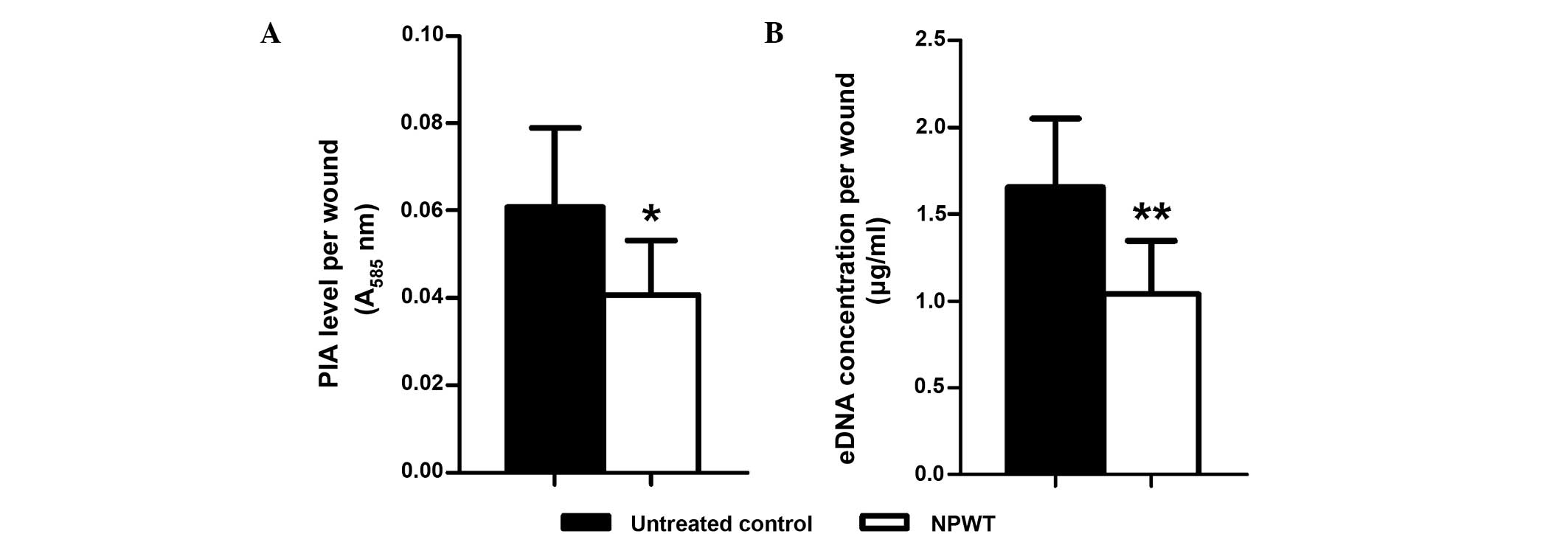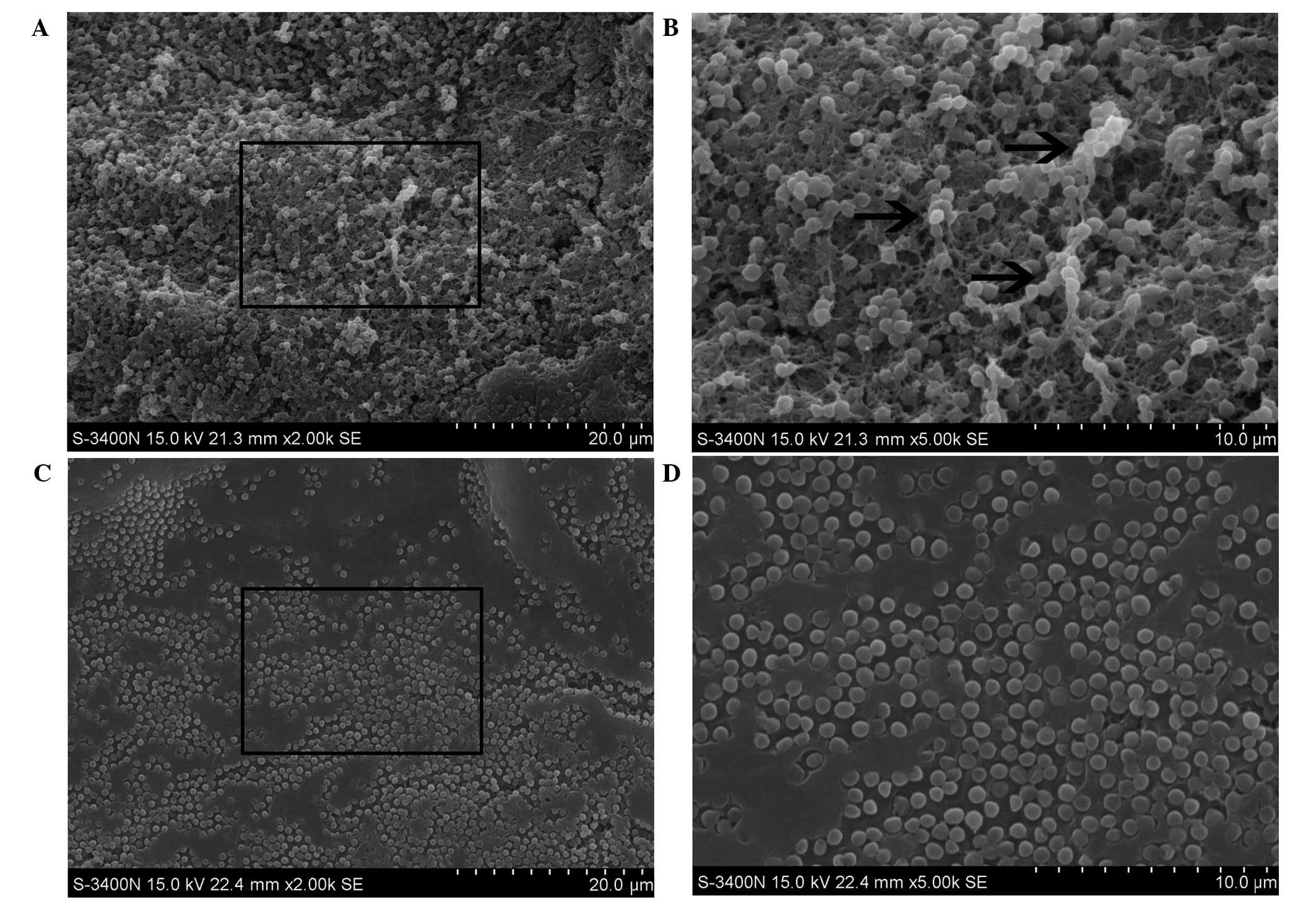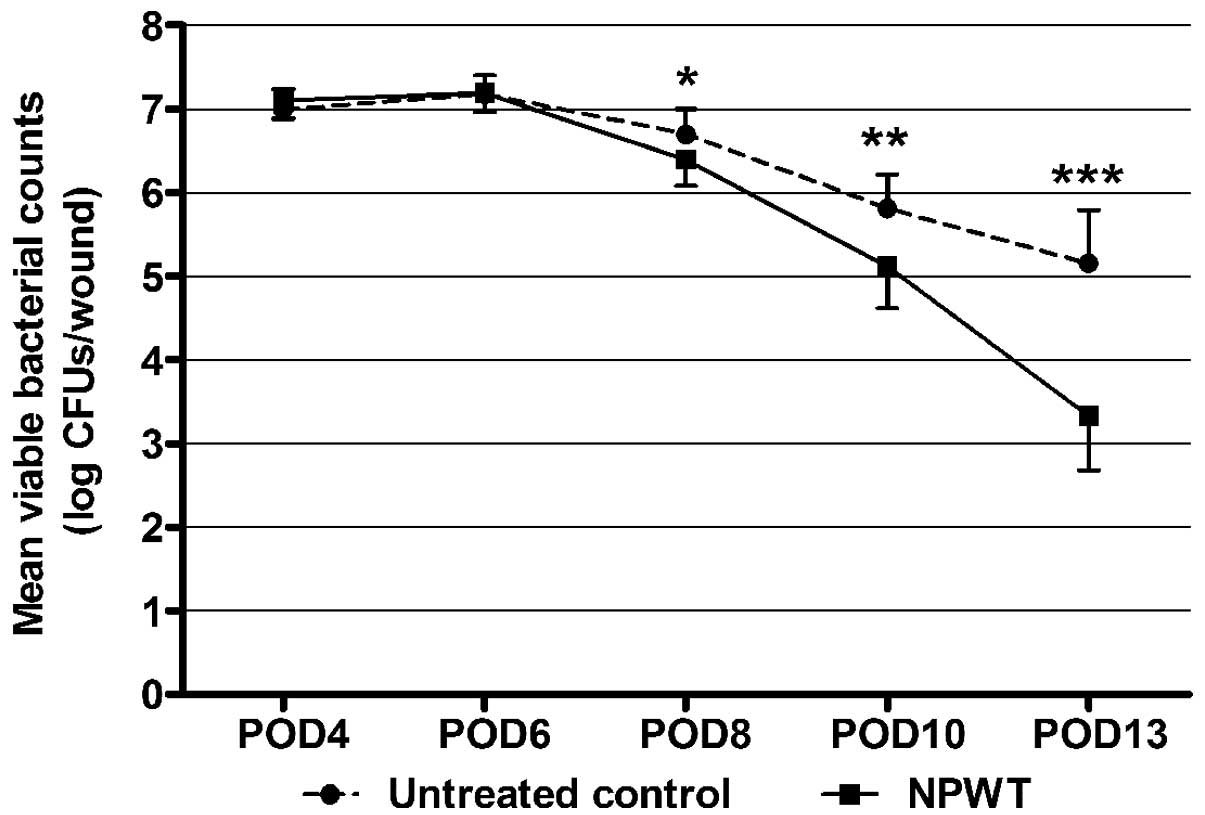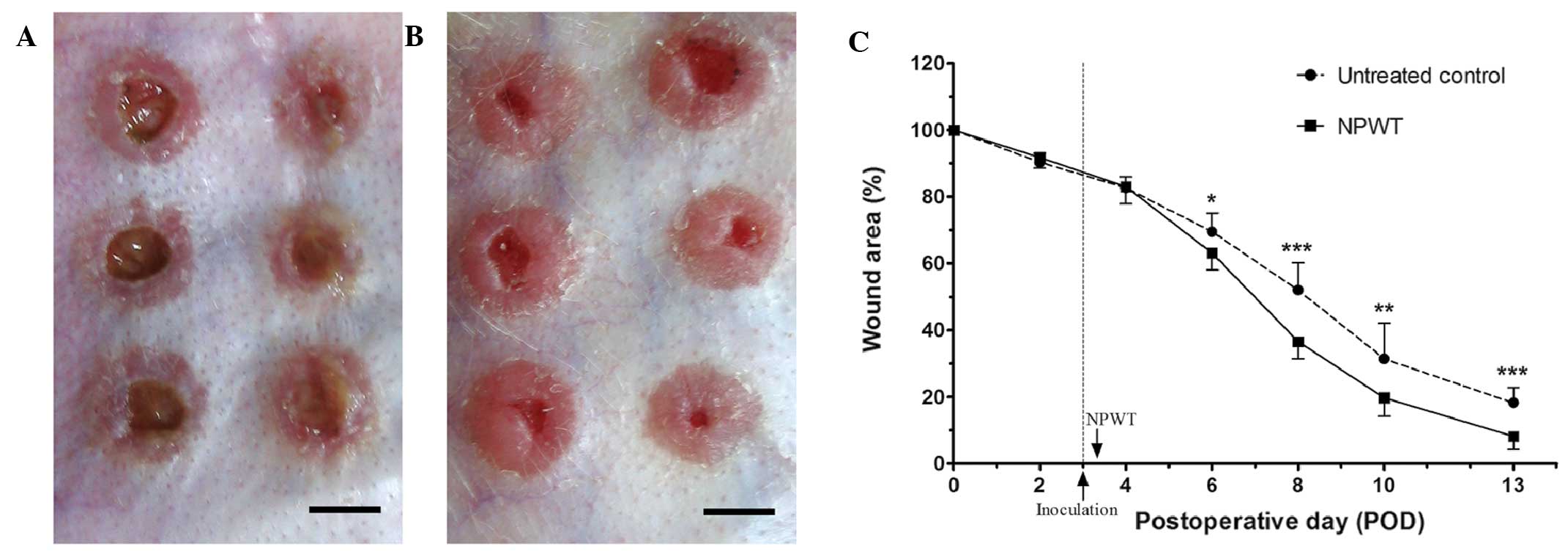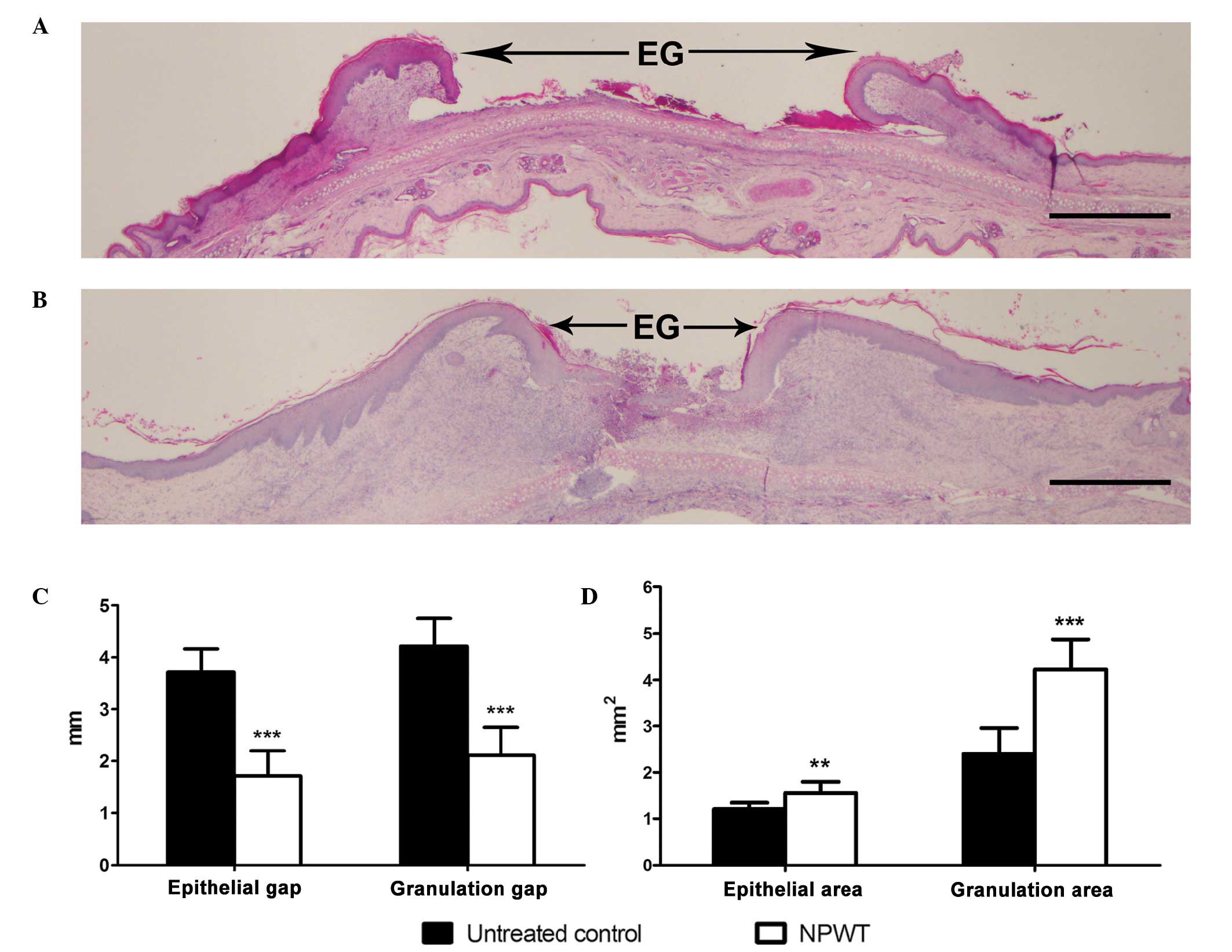|
1
|
Costerton JW, Stewart PS and Greenberg EP:
Bacterial biofilms: A common cause of persistent infections.
Science. 284:1318–1322. 1999. View Article : Google Scholar : PubMed/NCBI
|
|
2
|
Hall-Stoodley L, Costerton JW and Stoodley
P: Bacterial biofilms: From the natural environment to infectious
diseases. Nat Rev Microbiol. 2:95–108. 2004. View Article : Google Scholar : PubMed/NCBI
|
|
3
|
Parsek MR and Singh PK: Bacterial
biofilms: An emerging link to disease pathogenesis. Annu Rev
Microbiol. 57:677–701. 2003. View Article : Google Scholar : PubMed/NCBI
|
|
4
|
Edwards R and Harding KG: Bacteria and
wound healing. Curr Opin Infect Dis. 17:91–96. 2004. View Article : Google Scholar : PubMed/NCBI
|
|
5
|
Sen CK, Gordillo GM, Roy S, Kirsner R,
Lambert L, Hunt TK, Gottrup F, Gurtner GC and Longaker MT: Human
skin wounds: A major and snowballing threat to public health and
the economy. Wound Repair Regen. 17:763–771. 2009. View Article : Google Scholar : PubMed/NCBI
|
|
6
|
Lindsay D and von Holy A: Bacterial
biofilms within the clinical setting: What healthcare professionals
should know. J Hosp Infect. 64:313–325. 2006. View Article : Google Scholar : PubMed/NCBI
|
|
7
|
James GA, Swogger E, Wolcott R, Pulcini E,
Secor P, Sestrich J, Costerton JW and Stewart PS: Biofilms in
chronic wounds. Wound Repair Regen. 16:37–44. 2008. View Article : Google Scholar : PubMed/NCBI
|
|
8
|
Bjarnsholt T, Kirketerp-Møller K, Jensen
PØ, Madsen KG, Phipps R, Krogfelt K, Høiby N and Givskov M: Why
chronic wounds will not heal: A novel hypothesis. Wound Repair
Regen. 16:2–10. 2008. View Article : Google Scholar : PubMed/NCBI
|
|
9
|
Boles BR and Horswill AR: Staphylococcal
biofilm disassembly. Trends Microbiol. 19:449–455. 2011. View Article : Google Scholar : PubMed/NCBI
|
|
10
|
Moet GJ, Jones RN, Biedenbach DJ, Stilwell
MG and Fritsche TR: Contemporary causes of skin and soft tissue
infections in North America, Latin America, and Europe: Report from
the SENTRY Antimicrobial Surveillance Program (1998-2004). Diagn
Microbiol Infect Dis. 57:7–13. 2007. View Article : Google Scholar : PubMed/NCBI
|
|
11
|
Seth AK, Geringer MR, Nguyen KT, Agnew SP,
Dumanian Z, Galiano RD, Leung KP, Mustoe TA and Hong SJ:
Bacteriophage therapy for Staphylococcus aureus
biofilm-infected wounds: A new approach to chronic wound care.
Plast Reconstr Surg. 131:225–234. 2013. View Article : Google Scholar : PubMed/NCBI
|
|
12
|
Gurjala AN, Geringer MR, Seth AK, Hong SJ,
Smeltzer MS, Galiano RD, Leung KP and Mustoe TA: Development of a
novel, highly quantitative in vivo model for the study of
biofilm-impaired cutaneous wound healing. Wound Repair Regen.
19:400–410. 2011. View Article : Google Scholar : PubMed/NCBI
|
|
13
|
Sadovskaya I, Vinogradov E, Flahaut S,
Kogan G and Jabbouri S: Extracellular carbohydrate-containing
polymers of a model biofilm-producing strain, Staphylococcus
epidermidis RP62A. Infect Immun. 73:3007–3017. 2005. View Article : Google Scholar : PubMed/NCBI
|
|
14
|
Otto M: Staphylococcal biofilms. Curr Top
Microbiol Immunol. 322:207–228. 2008.PubMed/NCBI
|
|
15
|
Arciola CR, Campoccia D, Speziale P,
Montanaro L and Costerton JW: Biofilm formation in
Staphylococcus implant infections. A review of molecular
mechanisms and implications for biofilm-resistant materials.
Biomaterials. 33:5967–5982. 2012. View Article : Google Scholar : PubMed/NCBI
|
|
16
|
Bayles KW: The biological role of death
and lysis in biofilm development. Nat Rev Microbiol. 5:721–726.
2007. View Article : Google Scholar : PubMed/NCBI
|
|
17
|
Cramton SE, Gerke C, Schnell NF, Nichols
WW and Götz F: The intercellular adhesion (ica) locus is present in
Staphylococcus aureus and is required for biofilm formation.
Infect Immun. 67:5427–5433. 1999.PubMed/NCBI
|
|
18
|
O'Gara JP: ica and beyond: Biofilm
mechanisms and regulation in Staphylococcus epidermidis and
Staphylococcus aureus. FEMS Microbiol Lett. 270:179–188.
2007. View Article : Google Scholar : PubMed/NCBI
|
|
19
|
Wu X, Wang Y and Tao L: Sulfhydryl
compounds reduce Staphylococcus aureus biofilm formation by
inhibiting PIA biosynthesis. FEMS Microbiol Lett. 316:44–50. 2011.
View Article : Google Scholar : PubMed/NCBI
|
|
20
|
Sadovskaya I, Chaignon P, Kogan G, Chokr
A, Vinogradov E and Jabbouri S: Carbohydrate-containing components
of biofilms produced in vitro by some staphylococcal strains
related to orthopaedic prosthesis infections. FEMS Immunol Med
Microbiol. 47:75–82. 2006. View Article : Google Scholar : PubMed/NCBI
|
|
21
|
Schaber JA, Triffo WJ, Suh SJ, Oliver JW,
Hastert MC, Griswold JA, Auer M, Hamood AN and Rumbaugh KP:
Pseudomonas aeruginosa forms biofilms in acute infection
independent of cell-to-cell signaling. Infect Immun. 75:3715–3721.
2007. View Article : Google Scholar : PubMed/NCBI
|
|
22
|
Harrison-Balestra C, Cazzaniga AL, Davis
SC and Mertz PM: A wound-isolated Pseudomonas aeruginosa
grows a biofilm in vitro within 10 hours and is visualized by light
microscopy. Dermatol Surg. 29:631–635. 2003. View Article : Google Scholar : PubMed/NCBI
|
|
23
|
Akiyama H, Huh WK, Yamasaki O, Oono T and
Iwatsuki K: Confocal laser scanning microscopic observation of
glycocalyx production by Staphylococcus aureus in mouse
skin: Does S. aureus generally produce a biofilm on damaged
skin? Br J Dermatol. 147:879–885. 2002. View Article : Google Scholar : PubMed/NCBI
|
|
24
|
Seth AK, Geringer MR, Gurjala AN, Hong SJ,
Galiano RD, Leung KP and Mustoe TA: Treatment of Pseudomonas
aeruginosa biofilm-infected wounds with clinical wound care
strategies: A quantitative study using an in vivo rabbit ear model.
Plast Reconstr Surg. 129:262e–274e. 2012. View Article : Google Scholar : PubMed/NCBI
|
|
25
|
Wolcott RD, Rumbaugh KP, James G, Schultz
G, Phillips P, Yang Q, Watters C, Stewart PS and Dowd SE: Biofilm
maturity studies indicate sharp debridement opens a time-dependent
therapeutic window. J Wound Care. 19:320–328. 2010. View Article : Google Scholar : PubMed/NCBI
|
|
26
|
Schierle CF, De la Garza M, Mustoe TA and
Galiano RD: Staphylococcal biofilms impair wound healing by
delaying reepithelialization in a murine cutaneous wound model.
Wound Repair Regen. 17:354–359. 2009. View Article : Google Scholar : PubMed/NCBI
|
|
27
|
Roche ED, Renick PJ, Tetens SP, Ramsay SJ,
Daniels EQ and Carson DL: Increasing the presence of biofilm and
healing delay in a porcine model of MRSA-infected wounds. Wound
Repair Regen. 20:537–543. 2012.PubMed/NCBI
|
|
28
|
Seth AK, Geringer MR, Galiano RD, Leung
KP, Mustoe TA and Hong SJ: Quantitative comparison and analysis of
species-specific wound biofilm virulence using an in vivo,
rabbit-ear model. J Am Coll Surg. 215:388–399. 2012. View Article : Google Scholar : PubMed/NCBI
|
|
29
|
Brackman G, De Meyer L, Nelis HJ and
Coenye T: Biofilm inhibitory and eradicating activity of wound care
products against Staphylococcus aureus and Staphylococcus
epidermidis biofilms in an in vitro chronic wound model. J Appl
Microbiol. 114:1833–1842. 2013. View Article : Google Scholar : PubMed/NCBI
|
|
30
|
Watters C, Everett JA, Haley C, Clinton A
and Rumbaugh KP: Insulin treatment modulates the host immune system
to enhance Pseudomonas aeruginosa wound biofilms. Infect
Immun. 82:92–100. 2014. View Article : Google Scholar : PubMed/NCBI
|
|
31
|
Kaplan JB: Biofilm dispersal: Mechanisms,
clinical implications, and potential therapeutic uses. J Dent Res.
89:205–218. 2010. View Article : Google Scholar : PubMed/NCBI
|
|
32
|
Seth AK, Nguyen KT, Geringer MR, Hong SJ,
Leung KP, Mustoe TA and Galiano RD: Noncontact, low-frequency
ultrasound as an effective therapy against Pseudomonas
aeruginosa-infected biofilm wounds. Wound Repair Regen.
21:266–274. 2013. View Article : Google Scholar : PubMed/NCBI
|
|
33
|
Costello JP, Amling JK, Emerson DA, Peer
SM, Afflu DK, Zurakowski D, Jonas RA and Nath DS: Negative pressure
wound therapy for sternal wound infections following congenital
heart surgery. J Wound Care. 23:31–36. 2014. View Article : Google Scholar : PubMed/NCBI
|
|
34
|
Cheng HT, Hsu YC and Wu CI: Risk of
infection with delayed wound coverage by using negative-pressure
wound therapy in Gustilo Grade IIIB/IIIC open tibial fracture: An
evidence-based review. J Plast Reconstr Aesthet Surg. 66:876–878.
2013. View Article : Google Scholar : PubMed/NCBI
|
|
35
|
Steingrimsson S, Gottfredsson M,
Gudmundsdottir I, Sjögren J and Gudbjartsson T: Negative-pressure
wound therapy for deep sternal wound infections reduces the rate of
surgical interventions for early re-infections. Interact Cardiovasc
Thorac Surg. 15:406–410. 2012. View Article : Google Scholar : PubMed/NCBI
|
|
36
|
Anagnostakos K and Mosser P: Negative
pressure wound therapy in the management of postoperative
infections after musculoskeletal tumour surgery. J Wound Care.
23:191–194, 196-197. 2014. View Article : Google Scholar : PubMed/NCBI
|
|
37
|
Bradley BH and Cunningham M: Biofilms in
chronic wounds and the potential role of negative pressure wound
therapy: An integrative review. J Wound Ostomy Continence Nurs.
40:143–149. 2013. View Article : Google Scholar : PubMed/NCBI
|
|
38
|
Huang C, Leavitt T, Bayer LR and Orgill
DP: Effect of negative pressure wound therapy on wound healing.
Curr Probl Surg. 51:301–331. 2014. View Article : Google Scholar : PubMed/NCBI
|
|
39
|
Orgill DP, Manders EK, Sumpio BE, Lee RC,
Attinger CE, Gurtner GC and Ehrlich HP: The mechanisms of action of
vacuum assisted closure: More to learn. Surgery. 146:40–51. 2009.
View Article : Google Scholar : PubMed/NCBI
|
|
40
|
Morykwas MJ, Simpson J, Punger K, Argenta
A, Kremers L and Argenta J: Vacuum-assisted closure: State of basic
research and physiologic foundation. Plast Reconstr Surg. 117(7
Suppl): 121S–126S. 2006. View Article : Google Scholar : PubMed/NCBI
|
|
41
|
Liu D, Zhang L, Li T, Wang G, Du H, Hou H,
Han L and Tang P: Negative-pressure wound therapy enhances local
inflammatory responses in acute infected soft-tissue wound. Cell
Biochem Biophys. 70:539–547. 2014. View Article : Google Scholar : PubMed/NCBI
|
|
42
|
Ngo QD, Vickery K and Deva AK: The effect
of topical negative pressure on wound biofilms using an in vitro
wound model. Wound Repair Regen. 20:83–90. 2012. View Article : Google Scholar : PubMed/NCBI
|
|
43
|
Phillips PL, Yang Q and Schultz GS: The
effect of negative pressure wound therapy with periodic
instillation using antimicrobial solutions on Pseudomonas
aeruginosa biofilm on porcine skin explants. Int Wound J.
10(Suppl 1): 48–55. 2013. View Article : Google Scholar : PubMed/NCBI
|
|
44
|
Valente PM, Deva A, Ngo Q and Vickery K:
The increased killing of biofilms in vitro by combining topical
silver dressings with topical negative pressure in chronic wounds.
Int Wound J. doi: 10.1111/iwj.12248. PubMed/NCBI
|
|
45
|
Institute of Laboratory Animal Resources
(US). Committee on Care, Use of Laboratory Animals, and National
Institutes of Health (US). Division of Research Resources: Guide
for the care and use of laboratory animals (8th). (Washington, DC).
National Academies Press. 2011.
|
|
46
|
Lalliss SJ, Stinner DJ, Waterman SM,
Branstetter JG, Masini BD and Wenke JC: Negative pressure wound
therapy reduces Pseudomonas wound contamination more than
Staphylococcus aureus. J Orthop Trauma. 24:598–602. 2010.
View Article : Google Scholar : PubMed/NCBI
|
|
47
|
Assadian O, Assadian A, Stadler M,
Diab-Elschahawi M and Kramer A: Bacterial growth kinetic without
the influence of the immune system using vacuum-assisted closure
dressing with and without negative pressure in an in vitro wound
model. Int Wound J. 7:283–289. 2010. View Article : Google Scholar : PubMed/NCBI
|
|
48
|
Chen SZ, Li J, Li XY and Xu LS: Effects of
vacuum-assisted closure on wound microcirculation: An experimental
study. Asian J Surg. 28:211–217. 2005. View Article : Google Scholar : PubMed/NCBI
|
|
49
|
Burian M, Rautenberg M, Kohler T, Fritz M,
Krismer B, Unger C, Hoffmann WH, Peschel A, Wolz C and Goerke C:
Temporal expression of adhesion factors and activity of global
regulators during establishment of Staphylococcus aureus
nasal colonization. J Infect Dis. 201:1414–1421. 2010. View Article : Google Scholar : PubMed/NCBI
|
|
50
|
Reissig JL, Storminger JL and Leloir LF: A
modified colorimetric method for the estimation of N-acetylamino
sugars. J Biol Chem. 217:959–966. 1955.PubMed/NCBI
|
|
51
|
Lim Y, Levy MA and Bray TM: Dietary
supplementation of N-acetylcysteine enhances early inflammatory
responses during cutaneous wound healing in protein malnourished
mice. J Nutr Biochem. 17:328–336. 2006. View Article : Google Scholar : PubMed/NCBI
|















